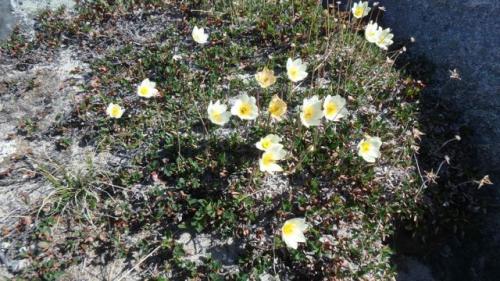Dedicated to the Nordonia Hills (Ohio) Garden Club
I spoke with members of the Nordonia Hills Garden Club before my departure. They compiled a list of questions about Arctic conditions and how they impact plants. I will do my best to answer the questions here!
Q. What do you see in the areas where the ice sheet is no longer there? What types of vegetation do you see?
A. There is a progression in how and where the ice has receded. First, however, let me define terms. A glacier is a (very slowly) moving river of ice; when it moves, it pushes everything in front of it. In fact, this is how the Great Lakes were formed more than 10,000 years ago. The pile of rocks and sand that is left when a glacier starts to melt back is called a moraine. You can see a moraine in front of the ice sheet as it is today.
 Glacier near the end of the Kanger Road.
Glacier near the end of the Kanger Road.
The moraine that you can see above was deposited there only a few hundred years ago. From the picture, it looks as if nothing grows there. Up close, however, it is possible to detect lichen and a couple of kinds of flowers including niviarsiaq or river beauty (Chamerion latifolium) and avens (Dryas integrifolia). (Niviarsiaq is Greenland's national flower and also a common name for girls; it means girl in Greenlandic.) It will take time to build up enough nutrients to support more plants there.
 Niviarsiaq, Greenland's national flower, grows on sand including river banks and moraines.
Niviarsiaq, Greenland's national flower, grows on sand including river banks and moraines.
 Dryas integrifolia prefers sandy conditions.
Dryas integrifolia prefers sandy conditions.
A side note here is that the glacier is not currently receding from this point; that is, it is not decreasing its surface area. However, it is getting shorter. In other words, ice melts at the bottom of all glaciers where they make contact with the ground, and Greenland's glacier is also melting across much of its surface in very warm years. For example, in 2012 98% of the surface of the ice sheet had melting occur. We can see that the glacier is lowering by observing that the ice is shorter than the moraine that it pushed forward. The glacier melted back from the area around Kanger 6,000-7,000 years ago. On this landscape we now find the tundra, an ecosystem made up of sandy soil, short plants, and no trees. The plants include grasses, woody shrubs, and perennial flowers.
 Tundra – look at the variety of textures and colors.
Tundra – look at the variety of textures and colors.
Q. What types of birds and insects are seen that are different from the area farther away?
A. From our sampling of insects, collected by netting them and by trapping them in bee bowls, carbon dioxide mosquito traps, and sticky traps, the insects are similar both at the ice sheet and 40km (24 miles) away in the town of Kangerlussuaq. I don't know anyone who is working on birds, but the songbirds I observe seem similar in both locations. I have also seen ravens, ducks, and geese. The insects that we see include: a wide variety of flies, one type of mosquito (Ades nigripes), syrphid (hovering) flies, bees (Bombus polaris and Bombus hyperboreus). On June 18 we also started seeing yellow and orange butterflies. I've seen lady bugs and wasps too. Interestingly, there are no ants at all in Greenland. There are certainly many types of spiders.
Q. What grows is controlled by many different factors. Just how different does this newly uncovered area look compared to the nearby ground that has been uncovered for many years?
A. As you say, there are many factors involved in the variation in ecosystems. I mentioned some above. However, I did not mention permafrost, and it has an important effect on plant-insect communities as well. Permafrost is soil that is frozen all year long. This is the condition of soil in Greenland as well as parts of Alaska, Canada, Norway, Sweden, Finland, and Russia. This is something we will be looking at more carefully next week. For the time being, however, I can tell you that, as we were trying to dig holes last week for another experiment, we found we could only dig down 4cm (less than 2 inches) in an area near the ice sheet. At a distance of 20 miles or so, we were able to dig a few inches before reaching permafrost. Icy subsoil is certainly a limiting factor for root growth. I look forward to talking to you in person next fall. I will have many more photos then. Something that I think you will find interesting is the plant species that are similar to, but smaller than, Ohio species!
Flag of the Day
 TJ's reindeer and musk ox flag.
TJ's reindeer and musk ox flag.

Comments